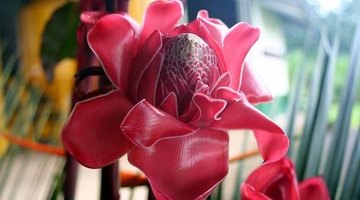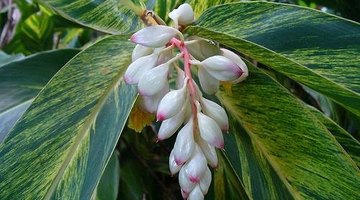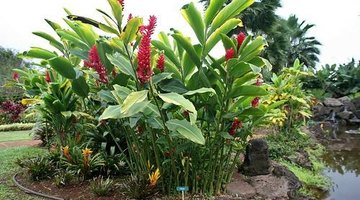How to Care for an Ornamental Ginger Plant
Ornamental gingers, while related to edibles, are usually grown for their looks instead of their flavor. They can be very rewarding to grow, and with some simple care will continue to produce beautiful leaves and flowers for many years.
Care and Maintenance

-
Determine what kind of ginger you have, and where it grows naturally. To have a healthy plant, your best bet is to simulate the conditions of its natural habitat. Ornamental gingers can be separated into two major groups: evergreens and non-evergreens. Evergreens will bloom year-round, and can be kept outdoors in the summer and indoors in the winter. Non-evergreens have a winter dormancy period during which they should be kept cool (50 to 60 degrees Fahrenheit) and dry until spring.
-
Make sure your ginger has a deep pot with plenty of drainage and room to grow. Ginger, like most bulbous plants, needs soil with good drainage and water retention. Ideally, you should use a rich, soil-based potting mix, although the "dancing ladies" variety of ginger prefers a peat-based mix.
-
Place your ginger plant in a spot where it will get plenty of light. Most gingers need bright, indirect light in order to flower; some even prefer full sun all day. A few gingers can thrive in filtered shade, but if your plant doesn't flower, you probably aren't giving it enough sun. If you bring your ginger plant indoors for the winter, make sure it still has lots of light.
-
Water your ginger regularly. Never leave it in standing water, but keep the soil consistently moist. The only exception to this is an evergreen ginger in winter, which should be allowed to dry between waterings. If your air is dry, mist your ginger daily. This will keep the leaves green and shiny, and your plant healthier overall.
-
Fertilize your ginger regularly with a balanced liquid fertilizer. During the growing season, fertilize once a month; while blooming, fertilize every 2 weeks.


References
Tips
- Repot ginger plants in the spring, at the beginning of their growing season. Gingers can be propagated by dividing the plant in the spring. Gingers do not need pruning, although you can pinch off blooms once they are finished. If your ginger plant is too large, divide it in spring and replant only the smaller part of the plant.
Warnings
- Gingers are subsceptible to spider mites. If your ginger plant has mites, introduce a natural predator such as lacewing or ladybugs.
Writer Bio
An award-winning blogger, Jessica Blue has been promoting sustainability, natural health and a do-it-yourself attitude since graduating University of California, Berkeley in 2000. Her work, seen in a wide variety of publications, advocates an environmentally-responsible and healthy lifestyle.
Photo Credits
- mackenzienicole - http://www.flickr.com/photos/mackenzienicole/2200892140/ , travelingmermaid - http://www.flickr.com/photos/travelingmermaid/3514360548/, cliff1066 - http://www.flickr.com/photos/nostri-imago/2858300222/
More Articles



